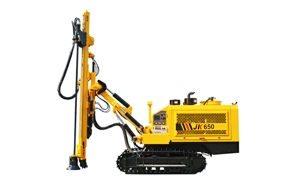Common engineering rig types and working principle
First, the impact drill
The vertical reciprocating motion of the drill causes the drill bit to impact the bottom of the well to break the rock formation. The structure is simple, there is no circulation washing system, and the removal of cuttings and the drilling machine cannot be performed at the same time, so the efficiency is low. Drilling depth is generally within 250 meters, sometimes up to 500-600 meters. There are two main types:
1. tophammer drill rig. Use the weight of the drill itself to impact the formation. The lower end of the drill is several sharp-angled flaps that can be folded. When the drill moves downward under its own weight, the flap opens and cuts into the rock layer, and then the drill is lifted by the winch through the wire rope, and the flap is closed. During the process, the cuttings are caught in the cone, and the cuttings are discharged from the wellhead. The drilling depth is usually 40 to 50 meters, and the deepest is 100 to 150 meters.
2. wire rope impact drill. It consists of a mast and a lifting pulley mounted on the top, a wire rope, an impact mechanism, a drill, and an electric motor. During operation, the motor drives the impact mechanism through the transmission device, and drives the wire rope to reciprocate the drill tool. When moving downward, the weight of the drill bit is cut into and fractured by the weight of the drill bit, and the upward movement is pulled by the wire rope. The drill stroke is 0.5 to 1 meter and the impact frequency is 30 to 60 times per minute. The cuttings are cleared from the ground by a sand pumping tube and drilled and removed simultaneously.
DTH Drilling Rig
Second, the composite drilling rig
There are two types: one is a water well rig that combines impact and slewing, such as a crawler mounted hydraulic DTH drilling rig. The down-the-hole hammer drill consists of a cylinder liner and a piston. High pressure air is supplied by the air compressor to push the piston up and down to reciprocate, and the drill bit is struck to enhance the drill bit's ability to drill into the rock formation. At the same time, the drill is rotated at a lower speed of 35 to 60 rpm. The air discharged from the upper and lower cavities of the piston enters the drill bit and carries the bottom cuttings out of the wellhead. The wind-driven down-the-hole hammer drill can be used for drilling deep wells in hard rock formations with high drilling speed and straight bore holes.
The other is to add an impact mechanism on the basis of the rotary rotary drilling machine, which is mainly based on rotary drilling. When the cobble layer is encountered, the two water well drilling rigs drilled by impact have strong adaptability to various formations.

评论
发表评论